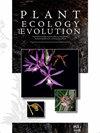Unusual massive phytoplankton bloom in the oligotrophic Lake Tanganyika
IF 1.1
4区 生物学
Q3 PLANT SCIENCES
引用次数: 6
Abstract
Background and aims – Massive algae growth resulting in a phytoplankton bloom is a very rare event in the meromictic and oligotrophic Lake Tanganyika. Such a bloom was observed in the north of the lake in September 2018. Phytoplankton species composition during this bloom is compared to a documented bloom in 1955, and to the composition in September 2011–2013. Meteorological observations suggest hydrodynamics could explain the occurrence of the 2018 bloom.Material and methods – Phytoplankton net samples were taken in the pelagic and littoral zone near Uvira during five consecutive days of the bloom in 2018. For the period 2011–2013, quantitative phytoplankton samples were obtained during a weekly sampling at the same sites. Samples were analysed with an inverted microscope and relative abundances of the algal species were compared. Key results – Dolichospermum flosaquae (Cyanobacteria) initially dominated the bloom followed by high relative abundance of Limnococcus limneticus (Cyanobacteria) on the third sampling day in September 2018. In the pelagic zone an increase of Nitzschia asterionelloides (Bacillariophyta), and Dictyosphaerium and Lobocystis (Chlorophyta) was observed while in the littoral zone increasing abundances of dinophytes were noted. Dolichospermum flosaquae was also responsible for the bloom reported in 1955, but was only sporadically observed in the 2011–2013 samples. Although Limnococcus limneticus was present in 2011–2013, it never reached relative abundances as high as during the 2018 bloom. Meteorological data indicate that 2018 experienced different conditions compared to previous years: strong south-east winds from May to September with a more eastern direction of the wind, and a well-marked drop in atmospheric pressure between August and September.Conclusion – After a very windy season, the combination of strong hydrodynamics, calmer lake conditions, and high solar radiation and air temperature in September 2018 was favourable for a massive Cyanobacteria bloom in the north of Lake Tanganyika.罕见的大量浮游植物在贫营养的坦噶尼喀湖开花
背景和目的——在亚微生态和贫营养的坦噶尼喀湖,大量藻类生长导致浮游植物水华是非常罕见的事件。2018年9月,在湖的北部观测到了这样的水华。将此次水华期间的浮游植物物种组成与1955年记录的水华以及2011-2013年9月的组成进行了比较。气象观测表明,流体动力学可以解释2018年水华的发生。材料和方法——在2018年连续五天的水华期间,在乌维拉附近的远洋和沿海地区采集了浮游植物网样本。2011-2013年期间,每周在同一地点进行一次浮游植物定量采样。用倒置显微镜对样品进行了分析,并对藻类物种的相对丰度进行了比较。关键结果-Dolichspermum flosaquae(蓝藻)最初主导了开花,随后在2018年9月的第三个采样日,Limnococcus limneticus(蓝藻)的相对丰度较高。在远洋区,观察到星状Nitzchia asteriolloides(Bacillarophyta)、Dictyosphaerium和Loocystis(Chlorophyta)的数量增加,而在沿海区,注意到恐龙植物的丰度增加。1955年报道的水华也是由多力子植物引起的,但在2011-2013年的样本中只是零星观察到。尽管Limnococcus limneticus存在于2011-2013年,但其相对丰度从未达到2018年开花时的水平。气象数据显示,与往年相比,2018年经历了不同的情况:5月至9月的东南风较强,风向更偏东,8月至9日的大气压力明显下降。结论——在经历了一个风很大的季节后,2018年9月,强大的流体动力学、平静的湖泊条件以及高太阳辐射和气温的结合,有利于坦噶尼喀湖北部出现大规模蓝藻水华。
本文章由计算机程序翻译,如有差异,请以英文原文为准。
求助全文
约1分钟内获得全文
求助全文
来源期刊

Plant Ecology and Evolution
PLANT SCIENCES-
CiteScore
2.20
自引率
9.10%
发文量
27
审稿时长
>12 weeks
期刊介绍:
Plant Ecology and Evolution is an international peer-reviewed journal devoted to ecology, phylogenetics and systematics of all ‘plant’ groups in the traditional sense (including algae, cyanobacteria, fungi, myxomycetes), also covering related fields.
The journal is published by Meise Botanic Garden and the Royal Botanical Society of Belgium.
 求助内容:
求助内容: 应助结果提醒方式:
应助结果提醒方式:


